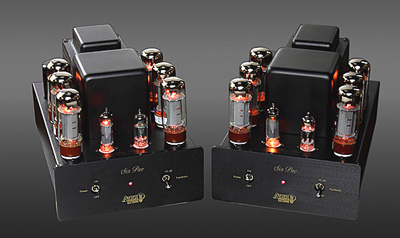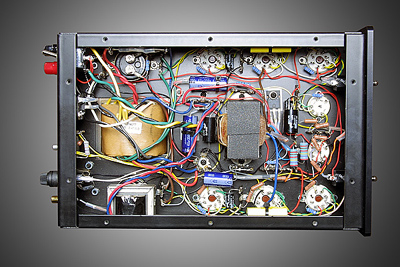You are reading the older HTML site
Positive Feedback
ISSUE
22
audio electronic supply Sixpac amplifiers
as reviewed by Ed Morawski

|
ED MORAWSKI'S SYSTEM
LOUDSPEAKERS
ELECTRONICS
SOURCES
CABLES
ACCESSORIES
|
Perhaps like many of you, I have, without realizing it, been on a long road to tube nirvana. Ten years ago, I would have laughed at the thought of owning tube gear, but the better my system got, the more I became seduced by the "dark" side. A big fork in the path came at CES one year, when I met Tim de Paravicini of E.A.R., who is quite outspoken about things audio. I wanted to find out if he knew what he was talking about, so I contacted Dan Meinwald, E.A.R.'s U.S. distributor. Dan turned me on to the E.A.R 864 tube preamp. I ended up buying the 864 and mating it with various solid-state amps, and these matings proved to be glorious combinations of musical sweetness and brawn. My journey down the valve road continued when I purchased a Musical Fidelity Nu-Vista CD player, which produced smooth, analog-sounding music. The system that consisted of the Musical Fidelity player, the E.A.R. 864, and the Bel Canto eVo II power amps remained in my listening room longer than any other.
A side trip occurred when I received the DK Design VS-1 MkII integrated (read that review here). This massive, beautiful piece of gear consisted of a tube preamp section feeding a solid-state power amplifier. After some tube rolling at the suggestion of DK Designs, I was certain that this was the end of my journey. I also kept the 864 and the eVo IIs for backup, and was pretty certain that these two systems would remain my references forever. I switched back and forth occasionally, and liked one just as much as the other. There was no clear winner. Nevertheless, as time passed, I wondered: If tubes in the preamp section sounded this good, what would an all-tube system sound like?

After hearing the tube amps of some fellow PFO reviewers, including Francisco Duran's Canaries and Bob Levi's E.A.R 890 (read that review here), it became obvious that I would have to try an all-tube system. The amplifier candidates were numerous, but I had enough requirements to whittle down the list. I wanted monoblocks because I have always enjoyed having two independent power supplies. I wanted at least twenty watts because I needed to be able to run a wide variety of speakers plus whatever might come here for review. I also didn't want to spend a fortune, in case tubes turned out to be not my thing. After doing some looking around, the AES (Cary Audio) Sixpacs seemed more and more like the logical choice. Their fifty watts seemed perfect, their readily available tube complement (a 12AX7 input gain/phase inverter, an EL84 current source for a 12BZ7, and six EL34 output tubes) made tube experimentation a breeze. Also, the price was right, at $2400 for the pair. Shortly thereafter, I had my own Sixpacs. While their appearance is not stunning, they do look purposeful, in an industrial, utilitarian way. I kept thinking how good they would look in a color other than black. Perhaps I will paint them at some time in the future.
I threw the power switches on both amps, and in a very short time I could feel waves of heat. I couldn't resist a quick listening session, but no sound came out of the left channel! I checked every connection and swapped cables, but the left amp was not producing sound. The hour was late, so I figured I would call AES the following morning, and send the amp back. Before doing so, I decided to check the bias, although the owner's manual hinted that it was already set. It turned out that the left channel had zero bias because the pot was turned down all the way! I set both amps to 230ma, and was rewarded with sound from both channels.
Once I recovered from the relief of hearing both amps, I was not pleased with the sound. While the bass was stronger than I expected, it was too flabby. The highs were too bright, and the mids were indistinct. The sound was constrained, like a middle-aged, overweight guy trying to run a marathon. Obviously the Sixpacs needed some break-in time. AES states 100 hours, so I left the amps playing all day every day for the next week. This was a little scary due to the extreme heat of the amps. When I returned home from work on the first day, my listening room rivaled a greenhouse in the middle of July. The amps were too hot to touch, and even the shelf above the amps was scalding. The Sixpacs can definitely reduce your heating bill during the winter.
I persisted, though, and by around 80 to 90 hours, the Sixpacs opened up like a BMW let loose on the Autobahn. The music soared. The Sixpacs now had great, tight bass and dynamic detail, not to mention a glorious midrange. I began playing some of my favorites, and the longer I played music, the better the Sixpacs sounded. They continued to improve, albeit more gradually, for the next 10 to 20 hours. By Monday, my new Shunyata Research Diamondback power cords arrived and I installed them on the Sixpacs. The improvement was very subtle and entirely in the bass, which sounded cleaner and firmer.
Then I tried some tube rolling. My amps came with Electro Harmonix 12AX7s. I had read reports on Audio Asylum that replacing these with NOS tubes worked wonders, and the reporters weren't kidding. The improvement was dramatic. I did a before-and-after comparison using Tift Merritt's Bramble Rose. This is acoustically rich country rock, recorded with plenty of twangy guitars, not to mention Tift's twangy voice. With the stock 12AX7s, there was good detail and very, very good bass. Her voice was sweet and very clear. I could easily hear words I had never been able to make out before. This was a real surprise, considering the supposedly high distortion of tube electronics. I then installed some NOS RCA 12BZ7s. When I played the same CD, I was struck by the improvement. The resolution didn't improve, but the attack and decay of each note was much more obvious and pleasant. The RCA 12B7s created an impression of air and transparency that was lacking with the stock tubes. Every guitar riff was magically evident. Even in the low end, notes were clearer and more defined. The vocal range was also better. Tift's voice became more vibrant, and exuded more emotion.
My next experiment was with the transformer taps. A pair of switches on the amps change the speaker outputs from 4 to 8 ohms. My speakers run at 4 ohms, and that's where I left the switch. When I tried the 8-ohm taps, I didn't hear much difference except a slight increase in volume. Another pair of toggles allowing switching between between 0 and 10 dBs of negative feedback. The manual recommends leaving these at zero, and I wholeheartedly concur. When I switched them to 10 dB, it was like stepping back twenty feet. The soundstage seemed to collapse.
Over the next few days I played many different musical genres, from jazz to classical and from bluegrass to rock. Acoustic music—my favorite by far—sounded wonderful through the Sixpacs, but rock and pop from Madonna, Fleetwood Mac, and Bananarama were also very well served. The hard driving sounds of Venus sounded gutsy, fast, and dynamic. This was a real surprise to me, because I had always heard that tube amps couldn't produce slam. The Sixpacs also play well at any volume. Their fifty watts per side is plenty for me.
As I write this, I am listening to Antigone Rising's From the Ground Up, and I feel my journey may be over. The Sixpacs impart considerable emotion and musicality to my favorite recordings. I often find myself replaying tracks, because of sheer enjoyment and to see if I really heard details I had not previously noticed. The Sixpacs make CDs sound more analog, without the hassle of viny. If you've been contemplating the "dark side," or are feeling seduced by glowing glass tubes, try the Sixpacs. You can't go wrong for the money! Ed Morawski
Audio Electronic Supply "Sixpac" triode monoblock amplifiers.
Retail: $2400/pr.
Cary Audio Design
TEL: 919. 481. 4494
web address: www.Sixpacs.com or www.caryaudio.com
e-mail: [email protected]
Read Sasha Matson review on the Sixpacs.
Ed is currently involved in the manufacturing of Olympic Loudspeakers.
